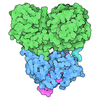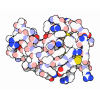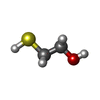+ Open data
Open data
- Basic information
Basic information
| Entry | Database: PDB / ID: 1bff | ||||||
|---|---|---|---|---|---|---|---|
| Title | THE 154 AMINO ACID FORM OF HUMAN BASIC FIBROBLAST GROWTH FACTOR | ||||||
 Components Components | BASIC FIBROBLAST GROWTH FACTOR | ||||||
 Keywords Keywords | GROWTH FACTOR | ||||||
| Function / homology |  Function and homology information Function and homology informationgrowth factor dependent regulation of skeletal muscle satellite cell proliferation / positive regulation of inner ear auditory receptor cell differentiation / positive regulation of neuroepithelial cell differentiation / regulation of blood vessel endothelial cell proliferation involved in sprouting angiogenesis / response to wortmannin / positive regulation of cell fate specification / regulation of cell migration involved in sprouting angiogenesis / positive regulation of lens fiber cell differentiation / positive regulation of endothelial cell chemotaxis to fibroblast growth factor / TGFBR3 regulates FGF2 signaling ...growth factor dependent regulation of skeletal muscle satellite cell proliferation / positive regulation of inner ear auditory receptor cell differentiation / positive regulation of neuroepithelial cell differentiation / regulation of blood vessel endothelial cell proliferation involved in sprouting angiogenesis / response to wortmannin / positive regulation of cell fate specification / regulation of cell migration involved in sprouting angiogenesis / positive regulation of lens fiber cell differentiation / positive regulation of endothelial cell chemotaxis to fibroblast growth factor / TGFBR3 regulates FGF2 signaling / regulation of retinal cell programmed cell death / Formation of intermediate mesoderm / FGFRL1 modulation of FGFR1 signaling / corticotropin hormone secreting cell differentiation / thyroid-stimulating hormone-secreting cell differentiation / chondroblast differentiation / lymphatic endothelial cell migration / negative regulation of fibroblast growth factor receptor signaling pathway / chemokine binding / POU5F1 (OCT4), SOX2, NANOG activate genes related to proliferation / angiogenesis involved in coronary vascular morphogenesis / Formation of the nephric duct / positive regulation of epithelial tube formation / stem cell development / regulation of endothelial cell chemotaxis to fibroblast growth factor / positive regulation of cerebellar granule cell precursor proliferation / receptor-receptor interaction / negative regulation of wound healing / hyaluronan catabolic process / inner ear auditory receptor cell differentiation / Signaling by activated point mutants of FGFR3 / FGFR3c ligand binding and activation / positive regulation of stem cell differentiation / Phospholipase C-mediated cascade; FGFR3 / cerebellar granule cell precursor proliferation / FGFR2b ligand binding and activation / fibroblast growth factor receptor binding / embryonic morphogenesis / behavioral response to ethanol / FGFR2c ligand binding and activation / Activated point mutants of FGFR2 / Phospholipase C-mediated cascade; FGFR2 / FGFR4 ligand binding and activation / FGFR1b ligand binding and activation / mammary gland epithelial cell differentiation / Phospholipase C-mediated cascade; FGFR4 / glial cell differentiation / Signaling by activated point mutants of FGFR1 / FGFR1c ligand binding and activation / organ induction / Downstream signaling of activated FGFR1 / Phospholipase C-mediated cascade: FGFR1 / paracrine signaling / Developmental Lineage of Pancreatic Acinar Cells / embryo development ending in birth or egg hatching / negative regulation of fibroblast migration / positive regulation of blood vessel branching / negative regulation of oxidative stress-induced neuron intrinsic apoptotic signaling pathway / histone H3K9me2/3 reader activity / cell migration involved in sprouting angiogenesis / endothelial cell proliferation / positive regulation of endothelial cell chemotaxis / positive regulation of cell migration involved in sprouting angiogenesis / positive regulation of vascular endothelial cell proliferation / positive regulation of DNA biosynthetic process / branching involved in ureteric bud morphogenesis / Signaling by FGFR2 IIIa TM / PI-3K cascade:FGFR3 / Syndecan interactions / PI-3K cascade:FGFR2 / positive regulation of neuroblast proliferation / PI-3K cascade:FGFR4 / PI-3K cascade:FGFR1 / positive regulation of stem cell proliferation / positive regulation of sprouting angiogenesis / chemoattractant activity / positive regulation of MAP kinase activity / positive regulation of cell division / negative regulation of blood vessel endothelial cell migration / Non-integrin membrane-ECM interactions / PI3K Cascade / fibroblast growth factor receptor signaling pathway / positive regulation of blood vessel endothelial cell migration / neuroblast proliferation / regulation of angiogenesis / canonical Wnt signaling pathway / positive regulation of osteoblast differentiation / response to axon injury / SHC-mediated cascade:FGFR3 / SHC-mediated cascade:FGFR2 / SHC-mediated cascade:FGFR4 / negative regulation of stem cell proliferation / SHC-mediated cascade:FGFR1 / positive regulation of cardiac muscle cell proliferation / FRS-mediated FGFR3 signaling / positive regulation of vascular associated smooth muscle cell proliferation / FRS-mediated FGFR2 signaling / FRS-mediated FGFR4 signaling / FRS-mediated FGFR1 signaling / Signaling by FGFR3 in disease Similarity search - Function | ||||||
| Biological species |  Homo sapiens (human) Homo sapiens (human) | ||||||
| Method |  X-RAY DIFFRACTION / DIFFERENCE FOURIER / Resolution: 2 Å X-RAY DIFFRACTION / DIFFERENCE FOURIER / Resolution: 2 Å | ||||||
 Authors Authors | Kastrup, J.S. / Eriksson, E.S. | ||||||
 Citation Citation |  Journal: Acta Crystallogr.,Sect.D / Year: 1997 Journal: Acta Crystallogr.,Sect.D / Year: 1997Title: X-ray structure of the 154-amino-acid form of recombinant human basic fibroblast growth factor. comparison with the truncated 146-amino-acid form. Authors: Kastrup, J.S. / Eriksson, E.S. / Dalboge, H. / Flodgaard, H. | ||||||
| History |
|
- Structure visualization
Structure visualization
| Structure viewer | Molecule:  Molmil Molmil Jmol/JSmol Jmol/JSmol |
|---|
- Downloads & links
Downloads & links
- Download
Download
| PDBx/mmCIF format |  1bff.cif.gz 1bff.cif.gz | 36.3 KB | Display |  PDBx/mmCIF format PDBx/mmCIF format |
|---|---|---|---|---|
| PDB format |  pdb1bff.ent.gz pdb1bff.ent.gz | 26.9 KB | Display |  PDB format PDB format |
| PDBx/mmJSON format |  1bff.json.gz 1bff.json.gz | Tree view |  PDBx/mmJSON format PDBx/mmJSON format | |
| Others |  Other downloads Other downloads |
-Validation report
| Summary document |  1bff_validation.pdf.gz 1bff_validation.pdf.gz | 438 KB | Display |  wwPDB validaton report wwPDB validaton report |
|---|---|---|---|---|
| Full document |  1bff_full_validation.pdf.gz 1bff_full_validation.pdf.gz | 445.7 KB | Display | |
| Data in XML |  1bff_validation.xml.gz 1bff_validation.xml.gz | 9.3 KB | Display | |
| Data in CIF |  1bff_validation.cif.gz 1bff_validation.cif.gz | 11.8 KB | Display | |
| Arichive directory |  https://data.pdbj.org/pub/pdb/validation_reports/bf/1bff https://data.pdbj.org/pub/pdb/validation_reports/bf/1bff ftp://data.pdbj.org/pub/pdb/validation_reports/bf/1bff ftp://data.pdbj.org/pub/pdb/validation_reports/bf/1bff | HTTPS FTP |
-Related structure data
| Related structure data |  4fgfS S: Starting model for refinement |
|---|---|
| Similar structure data |
- Links
Links
- Assembly
Assembly
| Deposited unit | 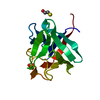
| ||||||||
|---|---|---|---|---|---|---|---|---|---|
| 1 |
| ||||||||
| Unit cell |
|
- Components
Components
| #1: Protein | Mass: 14800.098 Da / Num. of mol.: 1 Source method: isolated from a genetically manipulated source Source: (gene. exp.)  Homo sapiens (human) / Plasmid: PHD329 / Production host: Homo sapiens (human) / Plasmid: PHD329 / Production host:  |
|---|---|
| #2: Chemical | ChemComp-PO4 / |
| #3: Chemical | ChemComp-BME / |
| #4: Water | ChemComp-HOH / |
-Experimental details
-Experiment
| Experiment | Method:  X-RAY DIFFRACTION / Number of used crystals: 1 X-RAY DIFFRACTION / Number of used crystals: 1 |
|---|
- Sample preparation
Sample preparation
| Crystal | Density Matthews: 1.9 Å3/Da / Density % sol: 35 % | ||||||||||||||||||||||||||||||||||||
|---|---|---|---|---|---|---|---|---|---|---|---|---|---|---|---|---|---|---|---|---|---|---|---|---|---|---|---|---|---|---|---|---|---|---|---|---|---|
| Crystal grow | Method: vapor diffusion, hanging drop / pH: 7.5 Details: THE PROTEIN WAS CRYSTALLIZED FROM 30-40 % PEG1000 AND 0.2-0.3 % 2-MERCAPTOETHANOL BY THE HANGING DROP VAPOR DIFFUSION METHOD., pH 7.5, vapor diffusion - hanging drop | ||||||||||||||||||||||||||||||||||||
| Crystal grow | *PLUS Method: vapor diffusion, hanging drop | ||||||||||||||||||||||||||||||||||||
| Components of the solutions | *PLUS
|
-Data collection
| Diffraction | Mean temperature: 293 K |
|---|---|
| Diffraction source | Source:  ROTATING ANODE / Type: RIGAKU RUH2R / Wavelength: 1.5418 ROTATING ANODE / Type: RIGAKU RUH2R / Wavelength: 1.5418 |
| Detector | Type: XUONG-HAMLIN MULTIWIRE / Detector: AREA DETECTOR / Date: Jul 1, 1991 |
| Radiation | Monochromatic (M) / Laue (L): M / Scattering type: x-ray |
| Radiation wavelength | Wavelength: 1.5418 Å / Relative weight: 1 |
| Reflection | Resolution: 2→20 Å / Num. obs: 7035 / % possible obs: 84 % / Observed criterion σ(I): 0 / Redundancy: 2.2 % / Biso Wilson estimate: 22 Å2 / Rsym value: 0.047 / Net I/σ(I): 9.3 |
| Reflection shell | Resolution: 2→2.1 Å / Redundancy: 1.2 % / Mean I/σ(I) obs: 2.1 / Rsym value: 0.201 / % possible all: 46 |
| Reflection | *PLUS Num. measured all: 15506 / Rmerge(I) obs: 0.043 |
- Processing
Processing
| Software |
| ||||||||||||||||||||||||||||||||||||||||||||||||||
|---|---|---|---|---|---|---|---|---|---|---|---|---|---|---|---|---|---|---|---|---|---|---|---|---|---|---|---|---|---|---|---|---|---|---|---|---|---|---|---|---|---|---|---|---|---|---|---|---|---|---|---|
| Refinement | Method to determine structure: DIFFERENCE FOURIER Starting model: PDB ENTRY 4FGF Resolution: 2→20 Å / σ(F): 0 / Stereochemistry target values: TNT PROTGEO Details: THE B-FACTORS WERE REFINED USING PROLSQ. THERE IS ONE RESIDUE (SER 151) WITH DEVIATING PHI, PSI ANGLES IN THE RAMACHANDRAN PLOT.
| ||||||||||||||||||||||||||||||||||||||||||||||||||
| Refinement step | Cycle: LAST / Resolution: 2→20 Å
| ||||||||||||||||||||||||||||||||||||||||||||||||||
| Refine LS restraints |
| ||||||||||||||||||||||||||||||||||||||||||||||||||
| Software | *PLUS Name: TNT / Classification: refinement | ||||||||||||||||||||||||||||||||||||||||||||||||||
| Refinement | *PLUS Rfactor obs: 0.19 / Rfactor Rwork: 0.19 | ||||||||||||||||||||||||||||||||||||||||||||||||||
| Solvent computation | *PLUS | ||||||||||||||||||||||||||||||||||||||||||||||||||
| Displacement parameters | *PLUS | ||||||||||||||||||||||||||||||||||||||||||||||||||
| Refine LS restraints | *PLUS
|
 Movie
Movie Controller
Controller






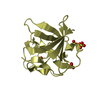

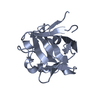
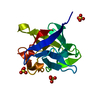

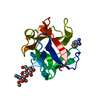

 PDBj
PDBj







